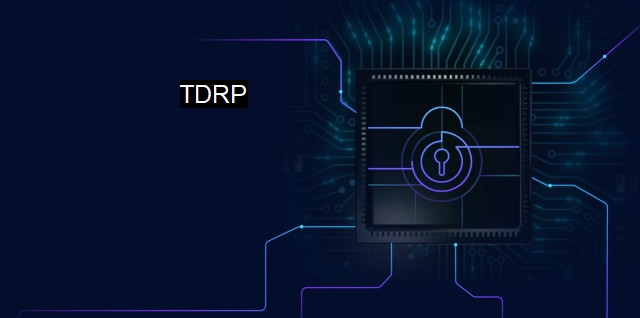What is TDRP?
The Increasing Importance of Cybersecurity and the Key Role of Technical Data Rights Program in Safeguarding Digital Data and Assets for Modern Organizations
The Targeted Dwell-time Reduction Program (TDRP) is an evolutionary paradigm in the realm of cybersecurity and antivirus. Also known as Threat Dwell Time Reduction Program, this framework even with its newer implementation has been a game-changer, revolutionizing the way we perceive and respond to threats within cyber infrastructure. it has been a cornerstone for businesses that are seeking ways to bolster their security preventive and response strategies against cyber security threats and breaches.The TDRP is fundamentally crafted to minimize or lower the “dwell time,” which is referential to the timeframe in which a cyber threat exists or resides undetected within a network ecosystem. This time may range anywhere from days to months, even sometimes spanning multiple years. The emphasis on reducing the dwell time lies in the fact that the longer a threat remains unnoticed, the more advantage it tends to gain, leaving businesses vulnerable to large-scale data breaches and significant damage potential.
TDRP sends out strong ripples within the cybersecurity practices due to the way it approaches threats. Conventionally, threat safeguarding mechanisms in digital frameworks have been notionally focused on avoiding breaches and attacks from happening in the first place. Although prevention indeed is the best medicine, expecting a foolproof system wherein the cyber threats can be entirely thwarted is not entirely viable.
Therefore, TDRP nudges organizations to shift their perspective from just evasion to detection and rapid-response methodologies. In more understandable terms, TDRP strives to fathom the reality of threat occurrence and desists on reconsidering how vulnerabilities can be found quickly and then neutralized at an unparalleled pace, hence improving the containment strategies and overall resilience towards cyber-themed hostility.
Implementing TDRP does not entail making massive structural alterations in a firm's existing cybersecurity and antivirus systems. Instead, it involves a strategic update in adapting protective hardwares or softwares to incorporate comparatively vigilant monitoring components. A geared-up mechanism conducive to the continual scanning, early alerts about odd activities, predictive analytics, and responsive protocols to handle a potential violation is an ideal attribute for TDRP.
To foster TDRP operationalization and efficiency, a string of cutting-edge technologies such as Artificial Intelligence (AI) and Machine Learning (ML) play a crucial role. AI and ML can seamlessly analyze colossal quantities of data to discern peculiar behavior or anomalies, thereby enabling the earliest possible detection of a threat entity. Accordingly, if analytic algorithms and learning-based models interlaced with TDRP constitutes the primary line of defense, vigorous, timely response and remediation measures form the secondary line of defense.
The objectives of TDRP are geared towards operating with a methodical-yet-dynamic inconsistency analysis. By this means, the actions deviating from the norm or established standard become readily identifiable, making it easier to distinguish legitimate activities from possibly malicious ones.
One needs to extricate that facilitating TDRP requires more than AI, ML, or unique algorithms. Fundamental to this is the adeptness of the human workforce overseeing the network that regularly uncovers, tracks, and mitigates threats. Therefore, a strategic synergy between human intellect and technology is central to unleashing the full potency of TDRP.
Amidst an ever-transitioning cyber environment peopled by sophisticated threat constituents, the Targeted Dwell-time Reduction Program emerges as a competency-enhancing strategic model. It stands empowering organizations for proactive defense, unveiling real-time threat intelligence, and bringing to light that indeed, effective cybersecurity is less about preventing intrusion and more about rapidly detecting and reactively expunging it. The ought-to-be-emphasized phrase here is adapting for faster, smarter, and totally encompassing defensive layers managed through conscientious, analytic, and responsive antivirus and security controls. TDRP strives to reinforce just that, with transformative results.

TDRP FAQs
What is TDRP in cybersecurity?
TDRP stands for Threat Detection and Response Platform, which is a security solution that provides constant monitoring and analysis of system data to identify and respond to security threats quickly and efficiently.How does TDRP work?
TDRP collects large amounts of data from various sources, including log files, network data, and endpoint data. It then analyzes this data to identify potential security threats using machine learning algorithms and other techniques. Once a threat is detected, TDRP can take automated actions to block the attack, isolate the affected device, or alert a security professional for further investigation.What are the benefits of using TDRP?
TDRP provides several benefits to organizations, including faster threat detection and response times, improved visibility into their security posture, and reduced risk of data breaches or other security incidents. It also allows security professionals to prioritize and focus on the most critical threats, rather than sifting through large amounts of data manually.Is TDRP a replacement for antivirus software?
No, TDRP is not a replacement for antivirus software. While antivirus software is designed to detect and remove known malware threats, TDRP is focused on detecting and responding to new or unknown threats. These solutions are complementary and should be used together to provide comprehensive protection against cyber threats.| | A | | | B | | | C | | | D | | | E | | | F | | | G | | | H | | | I | | | J | | | K | | | L | | | M | |
| | N | | | O | | | P | | | Q | | | R | | | S | | | T | | | U | | | V | | | W | | | X | | | Y | | | Z | |
| | 1 | | | 2 | | | 3 | | | 4 | | | 7 | | | 8 | | |||||||